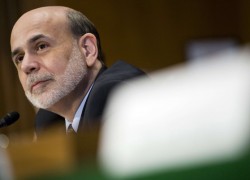The Federal Reserve announced Wednesday it would start to taper its aggressive bond-buying program to $75 billion a month beginning in January, propelling the market to a record close. 
The FOMC also announced it would lower its monthly long-term Treasury bond purchases to $40 billion and mortgage-backed securities to $35 billion a month, both reductions of $5 billion.
“I think it logically, this is what they had to do,” said David Kelly, managing director at JPMorgan Funds. “If you look at what’s happened this year, the unemployment rate has come down to 7 percent. We’ve got housing starts over a million units. We got the S&P 500 up 25 percent. In this economy, you have to pull back from the most extreme monetary policy in a century. So I think it’s overdue. I’m glad to see it.”
Nine of the voting members of the FOMC supported the decision to start tapering. Only Boston Fed President Eric Rosengren dissented, noting the elevated unemployment rate and inflation below the 2-percent target.
Bernanke said in his final news conference as Fed Chairman that the recovery remains “far from complete,” but if jobs gains continue as expected, the bond purchases would likely continue to be cut at a “measured” pace throughout next year.
Bernanke said he consulted closely on the decision with incoming Fed chief Janet Yellen.
“She fully supports what we did today,” Bernanke said.
Markets had first expected tapering to begin in September, and then began to shift their focus to December—or even later.
Ken Volpert, principal at Vanguard, predicted the Fed will taper by $10 billion.
“What we’re going to see in 2014 is reasonably good growth,” he said. “We don’t have the fiscal headwinds, or the fiscal drag as much in 2014, and we do have, you know, the deleveraging cycle, the consumer is getting towards the end. And so we are going to see some reasonably good growth, and I think the Fed is looking at that as well.”
Bob Doll, chief equity strategist for Nuveen Asset Management, called it “good news for equities.”
“The Fed is finally signifying to us the economy is doing better,” he said. “2014, the economy will be a bit stronger, a bit broader and this is just confirmation of it.”
Major averages shot higher following the announcement, with the Dow skyrocketing nearly 300 points. Both the Dow and S&P 500 closed at record highs.
In updated quarterly forecasts, the central bank pared back its expectations for both inflation and unemployment over the next few years, acknowledging the jobless rate had fallen faster than expected. It now sees it reaching a range of 6.3 percent to 6.6 percent by the end of 2014, from a previous prediction of 6.4 percent to 6.8 percent.
Tangible job growth has been at a focus of the central bank’s policymakers. In November, U.S. employers added a better-than-expected 203,000 jobs, with the unemployment rate dipping to 7 percent. The Fed has previously said it is looking for a 6.5-percent unemployment and 2.5 percent inflation rate before implementing an exit strategy from its $85-billion-a-month bond-buying program, also known as quantitative easing.
After nearly eight years, Ben Bernanke is stepping down as Fed chairman early next year. His designated successor, Vice Chair Janet Yellen, faces Senate confirmation this week. Yellen is known to lean dovish in her stance—favoring easy policy like Bernanke—which would likely bode well with markets.
This is the third round of QE since the financial crisis of 2008, and many investors believe that QE is the primary reason stocks have rallied since bottoming in March 2009.
The Fed posted a revised statement after noticing a minor error in the original version. However, there was no indication that the error affected the balance of the news.









